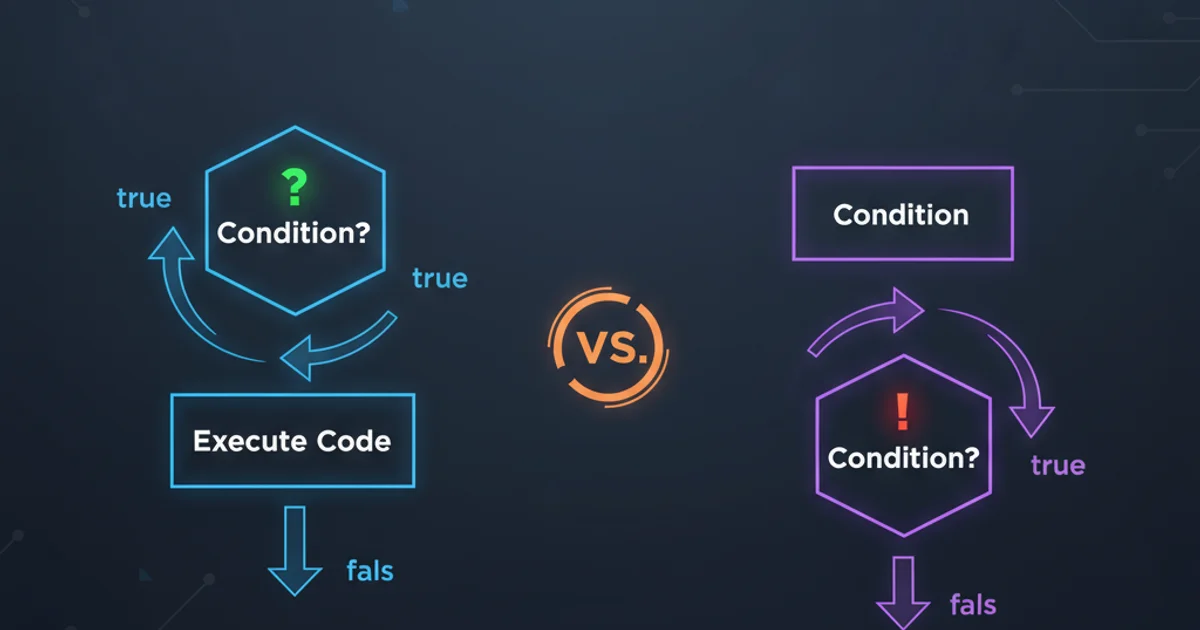do-while and while comparison
Categories:
Mastering Loops: A Deep Dive into Java's while vs. do-while

Explore the fundamental differences, use cases, and execution flow of while and do-while loops in Java, complete with practical examples and decision-making guidance.
Loops are essential control flow statements in programming, allowing a block of code to be executed repeatedly. In Java, two common types of loops are while and do-while. While they both facilitate repetition, their fundamental difference lies in when the loop's condition is evaluated. Understanding this distinction is crucial for writing efficient and bug-free code. This article will break down each loop, illustrate their behavior with examples, and provide guidance on choosing the right loop for your specific needs.
The while Loop: Condition-First Execution
The while loop is an entry-controlled loop, meaning it evaluates its condition before executing the loop body. If the condition is true, the loop body executes. If the condition is false from the start, the loop body will never execute. This makes the while loop suitable for situations where you might not need to execute the loop's content at all.
int count = 0;
while (count < 5) {
System.out.println("While loop iteration: " + count);
count++;
}
// Example where while loop doesn't execute
int x = 10;
while (x < 5) {
System.out.println("This will never print.");
x++;
}
Basic while loop demonstrating condition-first evaluation.
flowchart TD
A[Start] --> B{Condition is true?}
B -- Yes --> C[Execute Loop Body]
C --> B
B -- No --> D[End Loop]
D --> E[Continue Program]Flowchart illustrating the execution path of a while loop.
The do-while Loop: Guaranteed First Execution
In contrast to the while loop, the do-while loop is an exit-controlled loop. This means the loop body is executed at least once, and then the condition is evaluated. If the condition is true, the loop continues; otherwise, it terminates. This characteristic makes do-while loops ideal for scenarios where you need to perform an action at least once, such as reading user input until a valid value is provided.
int i = 0;
do {
System.out.println("Do-while loop iteration: " + i);
i++;
} while (i < 5);
// Example where do-while loop executes once
int y = 10;
do {
System.out.println("This will print exactly once: " + y);
y++;
} while (y < 5);
Basic do-while loop demonstrating guaranteed first execution.
flowchart TD
A[Start] --> B[Execute Loop Body]
B --> C{Condition is true?}
C -- Yes --> B
C -- No --> D[End Loop]
D --> E[Continue Program]Flowchart illustrating the execution path of a do-while loop.
Key Differences and When to Use Which
The primary distinction between while and do-while loops lies in their condition check timing. This difference dictates their appropriate use cases.
whileloop: Use when the loop body might not need to execute at all. This is common when iterating over collections that could be empty, or when a condition might be false from the outset.do-whileloop: Use when you need to guarantee that the loop body executes at least once. This is often seen in interactive programs where you prompt for user input, process it, and then check if more input is needed or if the input was valid.
while. If it must run at least once, use do-while.Practical Example: User Input Validation
Let's consider a common scenario: prompting a user for input and ensuring it meets certain criteria. A do-while loop is perfectly suited for this, as you always need to ask for input at least once.
import java.util.Scanner;
public class InputValidation {
public static void main(String[] args) {
Scanner scanner = new Scanner(System.in);
int age;
do {
System.out.print("Please enter your age (must be between 0 and 120): ");
while (!scanner.hasNextInt()) {
System.out.println("Invalid input. Please enter a number.");
scanner.next(); // Consume the invalid input
}
age = scanner.nextInt();
if (age < 0 || age > 120) {
System.out.println("Age must be between 0 and 120.");
}
} while (age < 0 || age > 120);
System.out.println("Valid age entered: " + age);
scanner.close();
}
}
Using a do-while loop for robust user input validation.
In this example, the do-while loop ensures that the user is prompted for their age at least once. The loop continues to execute as long as the entered age is outside the valid range (0-120). Notice the nested while loop to handle non-integer input, demonstrating how loops can be combined for complex validation.